The process of evolution is generally slow,
and it is no surprise that for centuries people thought that the living world
was static. However, there are situations where you can see the process in
action. Organisms with short life spans and high reproductive capacities, such
as bacteria or insects, can evolve in a very short time indeed. Also great
interest to evolutionary biologists is a polymorphism, a situation where two or
more different forms, morphs, of a species exist a population. Each morph
confers a different survival advantage in a different situation. Polymorphisms
such as that of wing colour in the peppered moth allow us to see how natural
selection leads changes in allele frequency, and so we can observe evolution in
action.
THE PEPPERED MOTH
The Figure below shows both forms of the peppered moth Biston betularia. This moth was common in the UK at the time of the Industrial Revolution. In areas of heavy industry, many buildings and trees became covered in soot. The speckled moth lost its camouflage in these areas and so was eaten more often by its predators. Luckily for the moth, a mutation occurred around this time that produced a black moth known as the melanic form. In industrialised areas, the melanic moth had a selective advantage. However, in ‘cleaner’ areas the reverse was true: the speckled moth thrived and the melanic form was rarely seen. Both morphs belong to the same species, but their survival depends largely on the environment.
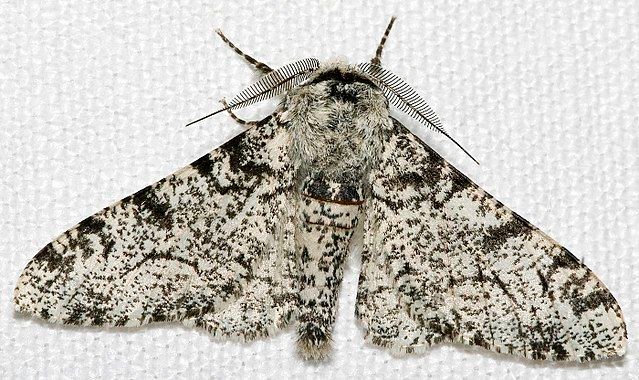
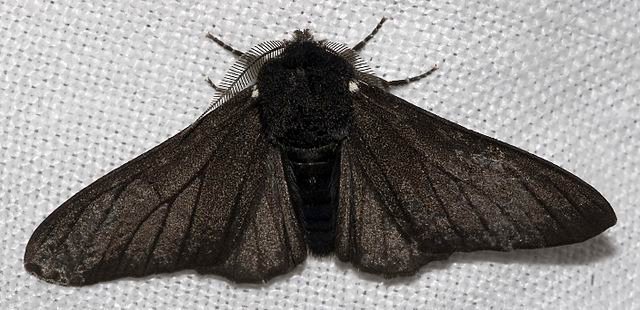
HOW CAN WE STUDY EVOLUTION?
If evolution is so slow, how can we observe it happening? An important principle here is that evolution involves a change in allele frequency. For instance, when myxomatosis was introduced into the rabbit population, the alleles for resistance were selected for, and so they increased in frequency. In any particular situation, if we can show that allele frequencies are changing, we know that evolutionary forces are at work.
Evolutionary studies are usually based on interbreeding populations, which are known as demes or Mendelian populations. The sum total of all the genes circulating within such a population is called the gene pool.
POPULATIONS AND ALLELE FREQUENCY
When the gene pool remains more or less the same, a population is not evolving. Natural selection may be acting, but it is often a force for stability rather than change. However, if the gene pool of a population is changing, natural selection is acting as a force for change and this is evolution in action.
To show how we measure allele frequency, imagine a population of 500 rats. In the population are two alleles for coat colour: black (B) is dominant over brown (b). The rats are diploid – each individual has two alleles – so the population contains 1 000 coat colour alleles. If 600 of the alleles are B, then we can say that the frequency of B is 60 per cent, or 0.6 (statisticians prefer decimals). As there are only two alleles, it follows that the frequency of b must be 40 per cent or 0.4. (Remember that the sum of the allele frequencies must be 100 per cent, or 1.)
If one gene is dominant to the other – as in this case – the symbol p is used the frequency of the dominant allele B, and q is used for the frequency of b. It is clear that p + q must equal 1. The values of p and q change when a population evolves. To find out if this is happening, we use the Hardy-Weinberg principle. p + q = 1 i.e frequency of dominant allele + frequency of recessive allele = total number of alleles of that gene.
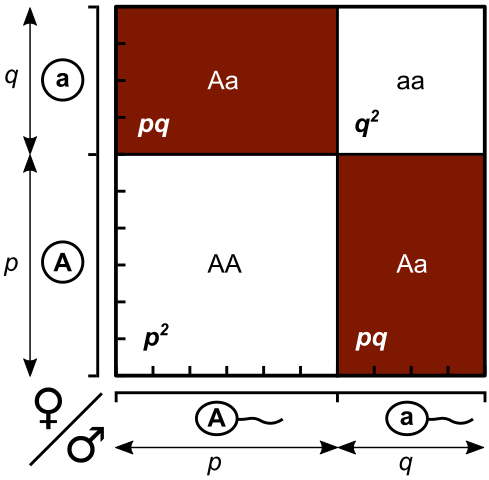
The Hardy-Weinberg principle
The principle, named after the British mathematician G.H. Hardy and the German biologist W. Weinberg, states that there will be no change in the frequency of alleles in a population so long as the following conditions are met:
- The population is very large, diploid and reproduces sexually.
- Mating is totally random – there is no tendency for certain genotypes to mate together.
- All genotypes are equally fertile, so there is no natural selection.
- There is no emigration or immigration.
- No mutations occur.
We can use the Hardy-Weinberg rule to estimate allele frequencies using just the information about the frequency of a particular genotype. Consider the example of albinism in humans. One in 10 000 humans are born albino – they have two copies of a recessive gene which means they cannot make the pigment which gives colour to hair, skin and eyes. The frequency of the allele for albinism in the population is difficult to estimate because carriers of the allele are not albinos. So, how can we find the frequency of the albinism allele?
If we call the normal allele A and the albinism allele a, most of the population are AA, some are carriers: Aa or aA, and a small number are albinos: aa. Using the Hardy-Weinberg formula we can estimate the percentage of the population who carry the a allele. Remember that p and a represent the frequency of the A and a alleles respectively. The Hardy-Weinberg equation is:
p2 + 2pq + q2 = 1
Put into words, it says:
The frequency of AA individuals, added to the frequencies of Aa, aA and aa, must equal 1.
We also know that p + q = 1, and we can use these two equations to work out the proportion of heterozygotes in the population, and any other frequencies involved:
1 in 10 000 is a frequency of 0.01 per cent, or 0.0001 expressed as a decimal.
1 in 10 000 has the genotype aa, so the frequency of aa; qq or q2, has the value of 0.0001.
So q = √0.0001 = 0.01.
If q = 0.01, then p must be 1 - q, which is 0.99. So, in other words, 99 per cent or 0.99 of the alleles in the human population are A. From this we can calculate that the number of carriers of the albino allele 2pq is:
2pq = 2 × 0.99 × 0.01 = 0.0198 = 0.02.
So, almost 2 per cent of the population carry the albinism allele.
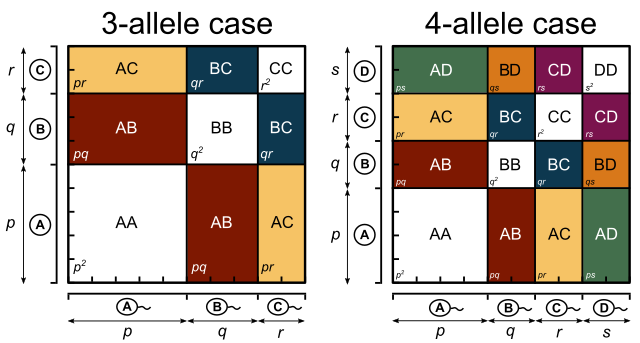
When allele frequencies change
The Hardy-Weinberg principle states that allele frequencies remain constant as long as certain conditions apply, It follows that when these conditions are not met, the allele frequencies can change and the population can evolve. Consider what happens when the conditions listed earlier are not met.
- The population is small: If the population is small, chance plays a large part in determining which alleles pass to the next generation. The smaller the population, the greater the probability that the genes of one generation will not be accurately represented in the next. The name given to change in allele frequency caused by chance is genetic drift. These are two important causes of genetic drift: bottlenecks, when a population declines and then recovers; and the founder effect, when a population starts from just a few individuals. This can result in a drastic change in the allele frequency.
- Mutations occur: Mutations are ultimately the origin of all genetic variation. They are rare, and most are harmful or neutral. Occasionally, however, a mutation gives an organism a survival advantage, or the environment changes so that previously harmful/neutral mutations become advantageous. For example, a mutation in a bacterial gene that leads to the production of a modified enzyme could make the bacterium resistant to an antibiotic. That individual would survive, even in the presence of the antibiotic, and pass its resistance gene on to the next generation.
- Individuals move in or out of populations: that is, immigration or emigration. If the new individuals breed, this movement may lead to gene flow. When a few individuals move into a new environment and start a population, we see the founder effect. The individuals in the founder population are probably not representative of the original population. A group of six human survivors on a desert island might have two red-haired people and two blondes. A population founded by these people would have a much higher percentage of red-heads and blondes than the population in their country of origin. In the most extreme case, a new population can be founded by one individual, such as a self-fertilising plant or a pregnant female animal.
- Mating is non-random: In many cases, individuals choose mates with a particular genotype. In this case, mating is not random, it is assortive. Such assortive mating can change allele frequency.
- Natural selection occurs: When there is competition for resources – and this is usually the case in an ecosystem – natural selection acts and only the most successful individuals pass on their genes.
Cheetahs – not fast enough to escape the bottleneck
It is widely known that the cheetah is the fastest land animal and is often hailed as a masterpiece of evolution. It is not so widely known, however, that this magnificent animal is, in genetic terms, on a knife edge. There is so little variation that the world’s cheetah population is practically a clone.
About 10 000 years ago there were probably five distinct species of cheetah. Four of them became extinct and the fifth one went through an evolutionary bottleneck in which very few individuals survived to produce the population of today. As a result the population is highly inbred – closely related individuals have mated and many alleles have been lost. In addition, any faulty genes are likely to be paired up and expressed rather than masked. It is difficult to breed cheetahs in captivity and a low sperm count is one of the major problems.
Polymorphic genes are those with more than one allele. In a major study of the world’s captive cheetahs, scientists detected no variation whatsoever in any of the 52 gene loci studied. The current estimation is that just 1 per cent of the cheetah’s genes are polymorphic, compared with about 23 per cent in the domestic cat and 31.7 per cent in humans.
In 1900, there were probably 100 000 cheetahs spread across Africa and Asia. Today, the cheetah is virtually extinct in Asia and there are only about 10 000 left in Africa. Of these, the biggest population is about 2500 in Namibia.
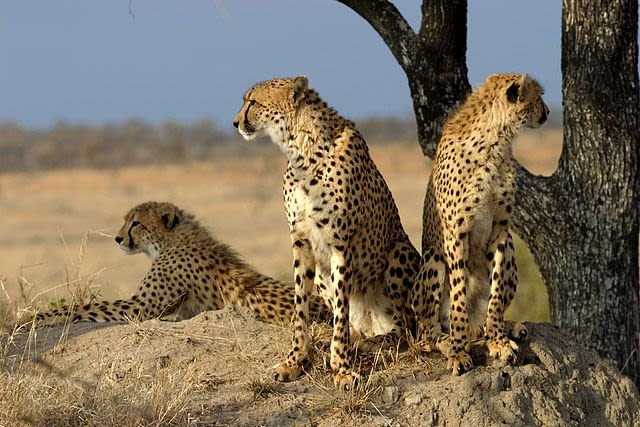
A group of cheetahs at Sabi Sand Game Reserve, South Africa. James Temple - Flickr, CC BY 2.0
THE DIVERSITY OF LIFE
There are millions of different species on Earth, and we have given all the one we know about a scientific name. The gorilla is simply Gorilla gorilla, the chimpanzee is Pan troglodytes while we have given ourselves the name Homo sapiens, which means ‘wise man’. A scientific name tells us both the genus and the species. The generic name has a capital letter while the specific name does not. When written, scientific names should always be in italics or underlined.
We classify organisms according to the similarities between them. Understanding relationships between species allows us to piece together the story of life on Earth. Classification is therefore a bit like a huge family tree over a massive time scale. Just like an address has a house number, a road, a town, and so on, we classify organisms into progressively narrower groups. The table below shows this ‘address’, which we more correctly call a taxonomic hierarchy. Taxonomy is the science of naming and classifying organisms and the term hierarchy reflects the layered structure of the family tree of living organisms that consists of groups within groups. This system of classification is called phylogenetic, i.e. based on evolutionary history. It is a bit like a family tree that goes back millions of years. To construct a phylogenetic tree, scientists use anatomical/physical features, fossil records and biochemical analysis of DNA and proteins.
The taxonomic hierarchy is shown in the table below. It has the following key features:
- It consists of a series of groups within groups, from the most general (kingdom) to the most specific (species).
- There is no overlap between the groups. For instance, there is no organism that is part amphibian and part reptile – it’s either in one group or the other.
- The groups are based on shared features. The more specific the group, the more shared features there are.
A table showing the taxonomic hierarchy of humans
| Taxonomic group | Name | Explanation |
| kingdom | Animalia | There are five kingdoms, animals, plants, fungi, protoctista and bacteria. We are animals. |
| phylum | Vertebrata | We are animals with backbones. |
| class | Mammalia | There are five classes: fish, amphibians, reptiles, birds and mammals. The defining features of mammals are fur/hair and milk production. |
| order | Primates | Primates are adapted for life in the trees. Key primate features will be discussed later in the article. |
| family | Hominidae | Human-like creatures – includes several extinct species. |
| genus | Homo | No other living species is sufficiently like humans to be included in this genus. |
| species | sapiens | We are the thinking species, modern man. |
Many scientists use an extra level in the hierarchy, the domain, which is even more general than the kingdom. First proposed in 1990, it is generally accepted that there are three domains, the Eukarota, the Archaea and the Bacteria. The Archaea are a type of bacteria that show features half way between those of a prokaryote and those of a Eukaryote. Eukaryote cells are large with a lot of internal organisation, i.e. Mny organelles made from membranes. Prokaryotic cells are much smaller – about a thousandth of the volume, and have little internal organisation.
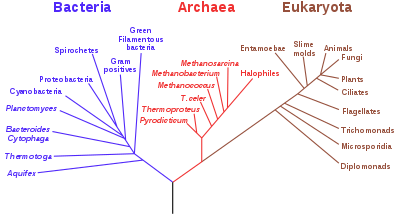
REFERENCES
https://www.britannica.com/animal/peppered-moth
https://en.wikipedia.org/wiki/Peppered_moth_evolution
http://www.mothscount.org/text/63/peppered_moth_and_natural_selection.html
http://bivalves.teacherfriendlyguide.org/index.php?option=com_content&view=category&id=20&Itemid=114
https://www.expii.com/t/approaches-to-studying-evolution-10018
https://en.wikipedia.org/wiki/Evolutionary_biology
https://www.nsf.gov/discoveries/disc_summ.jsp?cntn_id=126156
https://bmcgenet.biomedcentral.com/articles/10.1186/1471-2156-11-51
https://www.britannica.com/science/Hardy-Weinberg-law
https://www.britannica.com/science/Hardy-Weinberg-law
https://en.wikipedia.org/wiki/Hardy%E2%80%93Weinberg_principle
http://www.nature.com/scitable/definition/hardy-weinberg-equilibrium-122
https://en.wikipedia.org/wiki/Allele_frequency
https://www.nature.com/scitable/topicpage/the-genetic-variation-in-a-population-is-6526354
https://www.nature.com/scitable/definition/allele-frequency-298
https://hesc.co.za/species-hesc/cheetah/
https://academic.oup.com/jhered/article/108/6/671/3836924
https://virily.com/science-nature/cheetahs-not-fast-enough-escape-bottleneck/
Hello there @loveforlove :)
I see you have a wonderful series on Evolution going on here! I just wanted to let you know that I thoroughly enjoyed reading the previous article (which I only read now!) and the present one. From the previous one I appreciate very much the overview of the various mechanisms at play within natural selection. As for this one, I particulalrly liked the summary explaining the differences under which populations can evolve (as one tends to mostly focus on mutations and immigration/emigration).
Ps: I have always been fascinated by the case of the Peppered Moth. It reminds me of the very first readings/studies I did on evolution, natural selection etc... back in school! This is a great series my dear @loveforlove. Thank you for taking the time to present all this material to us!
All the best to you :*
Abigail.
Downvoting a post can decrease pending rewards and make it less visible. Common reasons:
Submit
I need to bookmark this to read all over again. Even though I did population genetics in school, it just dawned on me that I really didn't understand it then. This post makes it look simple. I think you should have stopped after the cheetahs case. I really enjoyed it up to that point. Learn to break posts into units as too long a read might be tiring.
Posted using Partiko Android
Downvoting a post can decrease pending rewards and make it less visible. Common reasons:
Submit
Thanks for coming and also for your kind comments @gentleshaid.
Downvoting a post can decrease pending rewards and make it less visible. Common reasons:
Submit
Thanks, dear @abigail-dantes.
I really appreciate you and the time you took in going through this post and the previous ones. I'm glad you enjoyed them.
Thanks once again, for the kind and lovely words. They serve as inspiration to me.
You are a very kind lady, Abigail. Lots of love. 😘
Downvoting a post can decrease pending rewards and make it less visible. Common reasons:
Submit
Congratulations @loveforlove! You have completed the following achievement on the Steem blockchain and have been rewarded with new badge(s) :
You can view your badges on your Steem Board and compare to others on the Steem Ranking
If you no longer want to receive notifications, reply to this comment with the word
STOPTo support your work, I also upvoted your post!
Downvoting a post can decrease pending rewards and make it less visible. Common reasons:
Submit
This post has been voted on by the SteemSTEM curation team and voting trail. It is elligible for support from @curie and @minnowbooster.
If you appreciate the work we are doing, then consider supporting our witness @stem.witness. Additional witness support to the curie witness would be appreciated as well.
For additional information please join us on the SteemSTEM discord and to get to know the rest of the community!
Thanks for having used the steemstem.io app and included @steemstem in the list of beneficiaries of this post. This granted you a stronger support from SteemSTEM.
Downvoting a post can decrease pending rewards and make it less visible. Common reasons:
Submit